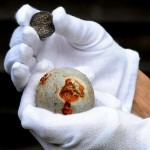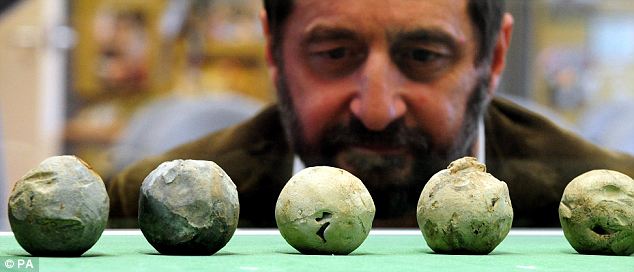The multi-year study funded by the Leicestershire County Council and the battlefield Trust has born surprisingly leaden fruit. The Battle of Bosworth was neither on Albion Hill, nor between the villages of Shenton, Stoke Golding and Dadlington, nor miles away in Atherton.
It’s two miles away from the fancy new visitor’s center, near Sutton Cheney. It turned out to be the last place they looked. No srsly. Battlefield archaeologist Glenn Foard picked one last spot, frustrated and defeated, to look for signs of the late 15th century battlefield which saw the demise of the last Plantagenet king, Richard III, and the ascendancy of the Tudor line.
 An hour later one of his diggers brought him a lead roundshot and he knew he’d hit proverbial paydirt. Not only is it good evidence that the Platangenets’ last stand, took place there, it’s also majorly new information about late medieval battlefield technology.
An hour later one of his diggers brought him a lead roundshot and he knew he’d hit proverbial paydirt. Not only is it good evidence that the Platangenets’ last stand, took place there, it’s also majorly new information about late medieval battlefield technology.
Abandoned cannonballs and bullets are a gift to battlefield archaeologists because they decay far less quickly than iron and steel handweapons and because, if they are made of lead like the ones at Bosworth, their condition shows what happened to them, from the pressure they were fired under to what they hit when they landed.
The Bosworth discoveries range in size from musket balls up to a 7.2kg cannonball. They are distributed in two clusters and may have been fired by both sides.
Excavators ended up finding 22 pieces of lead cannon and musket shot, more than the total from every other 15th and 16th century battlefield in Europe combined.
The Battle of Bosworth took place August 22, 1485. Before now, the earliest known evidence of moving artillery on the battlefield was 10 years later, during the French invasion of Italy from 1494-95. Finding such a huge cache of lead shot so early rewrites military history books.
The also found period coins, swords, buckles,
The exact location is being kept secret for now to keep the looters from tearing it up. The next step for the Trust and County Council are to raise the funds for further in situ study.

As always your blog is very interesting and thus I’m daily checking for updates. It feels rather unfair to go nitpicking on this one, especially since it is just a typing error, but as you know in history: it has to be correct. 😉
In the third alinea, second phrase you wrote “Platangenets” where I believe it is Plantagenets (in French it’s Plantagenêt).
Thank you. I’ve fixed the typo. I’m a horrible proofreader so I always appreciate a correction. :thanks:
Really interesting. I just finished Richard III, and the setting seems so medieval (the play, of course, isn’t)–it really changes everything to imagine big clouds of smoke hanging over Bosworth, and the battle mayhem punctuated by explosions rather than (only) clanging steel…
You know, I hadn’t even considered that before you mentioned it. It really is a whole different battle.
I have a small thing that lookes like a musket ball.I am going to Market bosworth today to see if it is a musket ball.